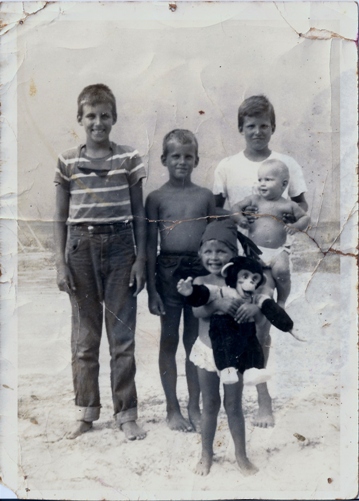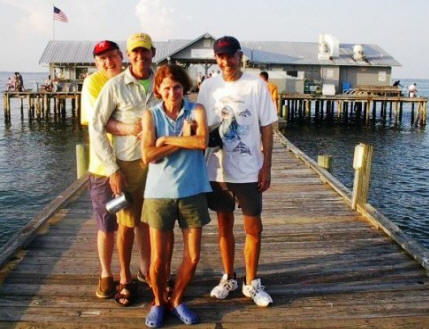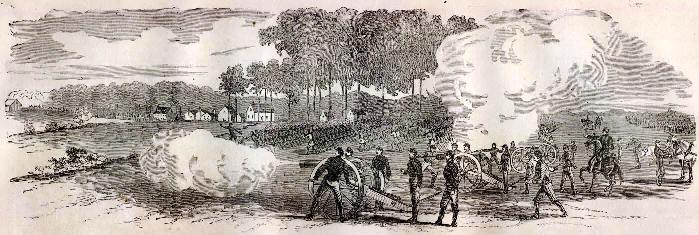Dear Donald,
Jerrems tree, have colaborated on this month’s story
line.
Joseph Jerrems b1814 was Sandra’s great
great grandfather.
We usually wait to publish the last week of the month,
except for November. Enjoy Thanksgiving!
Next month we will include your Christmas
greetings
from the past…and the present. If you have an old
family Christmas card, send it to me. We have three
so far.
| The Jerrems Family Goes to War in the United States |
Ray Jerrems, Our Genealogist, Historian

Introduction
We have not had an edition of the Jerrems
Journal devoted to a United States topic since April of
this year so I thought that it is about time we went back
to the United States in this edition. And what better
topic to choose in terms of drama and impact than the
American Civil War?
Although this War took place over 140 years ago it had
a profound effect on the psyche of the people of the
United States which is difficult for me (as an
Australian) to describe adequately. Perhaps its impact
on those people could best be compared with the
impact of Gallipoli (in the First World War) on
Australians.
Ken Burns’s documentary “The Civil War” (now a
DVD) is essential viewing for an understanding of that
War.
This article describes the involvement of the Jerrems’
extended family in the Civil War, following on from brief
references to this involvement in earlier editions of the
Jerrems Journal.
One of the legacies of the Civil War was the haunting
songs it produced. In the November 2006 Journal we
published an Email From Heaven from Big Bill about
previous Thanksgiving Dinners in Heaven where he
said “After the Civil War ended Samuel and Jesse
Jerrems celebrated by bringing some of their
friends
(including several Johnny Rebs) along. They sang
some of the Civil War songs to us, but the songs (for
instance “The Vacant Chair” and “Lorena”) were so
melancholy that everyone ended up in tears. I could
understand why the Army Generals had banned the
singing of “Lorena” by their soldiers. On the plus side
it was good to see that all the soldiers on both sides
had become good friends.”
In that item I attempted to capture a lasting (and very
poignant) part of the heritage of the Civil War. Now I
would like to follow this up with more observations.
Five men from one Jerrems’ extended family (I will
explain the reason for this term later) served in the
Civil War. One was discharged early for undisclosed
reasons, one was wounded and one died a few years
later, but the family also dispersed to quite a degree,
possibly as a result of the War.
Structure of this article
This article (a) defines the “Jerrems extended family”
(b) talks about the Civil War in general, and (c)
outlines the early history of the Regiment that the men
joined. A second article then concludes with the
service record of each of the men (who signed up at
different times) and a summary of their later lives. The
bulk of the material has been compiled from
Sandra
Walcyk’s research.
The Jerrems extended family
In the July 2008 edition of the Jerrems Journal I wrote
about James Jerrems and his family. James
had
been born in Wappenham in England in 1812 and
later migrated to the Utica area in the United States
with his wife Ann. James had 3 sons and 5 daughters
by his first marriage, the sons being James H (born
1837 or 1838), Thomas William (born 1839) and
Jesse (born 1840). Later James married Esther
Colbrook, a widow who already had a son (Robert
Colbrook born 1841) and 2 daughters by her first
marriage. Some time after Esther died James
married Caroline Mayborn (also a widow) who already
had a son (Thomas Mayborn born 1845) by her first
marriage. Robert Colbrook and Thomas Mayborn
were therefore stepsons of James Jerrems
Snr. All
five men signed up at varying times.
Incidentally, the name “Samuel Jerrems” referred to
earlier was incorrect; it was probably a transcription
error from the Civil War records.
Genesis of the Civil War, high casualty rates
My World Book Encyclopaedia says that historians
have never reached any general agreement about the
causes of the Civil War. Some believe that the slavery
issue was the basic cause. Others think that the war
resulted from economic rivalry between the industrial
North and the agricultural South. Most agree that many
factors contributed to the situation, with slavery basic
to the issue.
Whatever the cause, the immediate result was that the
Confederate States sought to secede from the Union,
and the “Union” States retaliated.
The human cost was enormous, with about 500,000
deaths, the majority (280,000) from disease. The 220,
000 battle deaths were over 3 times the Australian
casualties in the First World War and twice the
American casualties in that war.
Early air of unreality
The first battle of the Civil War took place fairly close to
the city of Washington. Confederate troops came north
by train and Union troops came south by train.
Reputedly some of the good citizens of the city packed
their picnic baskets and flocked out to watch the fun.
Readers will see later that a similar air of unreality
existed initially in Utica, NY, far to the north,
where
the
Jerrems boys lived.
Previous history of the Utica Regiment
Thomas, Jesse and James Jerrems and Thomas
Mayborn joined “A” Company of the 14th New York
Volunteer Infantry (popularly known as “The Utica
Regiment”), and Robert Colbrook joined Company “B”
of that Regiment. Thomas enlisted at the outset of the
War and the other men enlisted later.
Company “A” was originally constituted in 1808 and
had served in the 1812 Indian Wars. After the Civil
War it would serve in the Spanish War (1898-9) and
the First World War.
The following extracts in italics are from a book
published by the Utica Citizens Corps Veterans
Association in 1938. Sandra has a copy of the
book. What better way to describe the Regiment’s
involvement in the War than a first-hand account! I
have retained the language used in the book wherever
possible and I have added headings to make the
account flow. I have also added my comments in the
form of “Notes”. I am sure that readers will find the
account to be illuminating.
Editor’s Note: Thanks to Sandra for scanning
the images.
Header Image: Battle of Mechanicsville June 62 from
Harpers Weekly
Content Image: 14th NY Regiment
Let the War begin
On Saturday morning, April 13th 1861 the City of
Utica
awoke to the realization that Civil War had come. On
April 15th came President Lincoln’s proclamation
which called for 75,000 volunteers to suppress the
rebellion. Locally, a meeting of all independent
company commanders was held to plan united local
action. At this meeting it was declared that “It is the
duty of every citizen to respond promptly to the call of
his country” and it was resolved “That the [Utica]
United Citizens Corps hereby tender their services to
the Governor of this State as volunteers to join any
force that may be raised to meet the demand of the
General Government for forces against the traitors in
the South”.
My notes: Use of the
words “suppress the rebellion, “call of his country”
and “traitors” shed an
interesting light on how the Confederates were viewed
by Union supporters.
The Regiment gathers for the War and sets off
By April 16th the armory of the Corps was a scene
of
tremendous activity and colour. Flags, muskets and
fatigue caps decorated the entrance and the
windows. On April 23rd the Corps [including Thomas
Jerrems] made its farewell parade and an
enthusiastic yet grave and thoughtful crowd followed
them and lined the streets. Following the parade the
boys left their uniforms for the home company. They
then marched to the New York Central Freight Station
in Utica and, amid scenes of wild enthusiasm and of
tears and cheers, they entrained for Albany [100 miles
to the east] just after midnight.
Food was hard to obtain in Albany and the company’s
commanding officer “went good” personally at one of
the local restaurants for the company. Two bushels of
delicacies were received from a Utica Ladies
Committee.
On May 8th the companies were accepted by the State
as volunteers for 2 years.
The uniforms and rifles finally arrive, and the boys
see
the President
On May 21st the badly needed uniforms were issued.
The first dress parade was held, and a delegation of
ladies from Utica presented the Regiment with silk
national colours. On June 15th rifles stamped 1845
were issued, and 2 days later the 740 men marched
to the steamboat landing and travelled in the “Henry
Andrews” down the Hudson River to New York City,
where they received a half day of rest and 40 rounds of
ammunition.
The regiment was then shipped to Washington in
cattle cars, receiving a lunch at Philadelphia from the
Ladies Committee. They arrived in Baltimore 2 days
after a Massachusettes regiment had been assaulted
by spectators and mobbed, but our boys marched
through the city with fixed bayonets, unmolested.
In Washington the regiment was marched to the White
House lawn and given a quart of coffee and 2 ham
sandwiches each, on President Lincoln’s invitation.
While the men were eating the President sat in full
view on the verandah.
My notes: (1) Perhaps our police should also
carry fixed bayonets to control crowds. (2) I am a great
admirer of President Lincoln, inviting the men to eat
lunch on the White House lawn where they could see
him was a masterly touch. (3) I will comment in my
second article on the antiquated 1845 rifles issued to
the Regiment.
The Regiment marches out of Washington and
later sets up winter camp
In July the Regiment witnessed part of the Union
retreat after the Battle of Bull Run, and, after several
skirmishes, set up camp at Minor’s Hills (named after
a George Minor who lived there during the Revolution).
This camp was destined to be a long one as the
regiment spent the entire winter here. The men,
during the winter, rebuilt their tents into semi-dugouts
or shacks which were more comfortable. Also, many
people from Utica visited.
There was some sickness during the winter and 2
men died. A picket line was maintained as the
Confederates were about 3 miles to the south.
My notes: 1) The Battle of Bull Run was in
military
terms an inconclusive battle, marked by a disorderly
retreat by Union troops. It demonstrated to the North
the seriousness of the war ahead. Both sides began
to consolidate their forces and train their men further.
(2) There are several different spellings of the location
of the camp, which Sandra says is northeast of Falls
Church, Virginia and northwest of Arlington, Virginia.
This concludes my extracts from the book.
Photograph of the parade ground of the Minor Hills
Camp
The photograph of the Regiment in their Camp shows
a large parade ground with curious arches in the
background, probably made by bending trees over
and tying them at the top. It is possible that each
Company of the Regiment was camped beyond one
of the arches and marched out under it when going to
the parade ground. It is of course impossible to
identify Thomas in the photo, but it is an intriguing
thought that he was in it somewhere.
Spending Christmas in Camp
The citizens of Utica kept in contact with the troops
and it is therefore safe to assume that the troops were
supplied with appropriate food for the festive season.
However the troops would have felt homesick, and the
fact that the Confederates were camped only 3 miles
away would have put a dampener on proceedings.
The men would have been rostered to guard the
picket lines during day and night as a precaution, to
guard against attack from the “Johnny Rebs”.
When you are tucking in to your Christmas dinner in a
few weeks time spare a thought for Thomas, who
spent his Christmas in an army camp 148 years ago.
Thomas Jerrems is discharged
Thomas was discharged for undisclosed reasons in
January while at the Camp. Perhaps he had been
sick, or had been wounded in one of the earlier
skirmishes. The earlier reference to sickness in the
camp would indicate that sickness was the most likely
cause.
Later contributions of the Regiment to the Civil
War
The Regiment took part in (1) the siege and capture of
Yorktown (not to be confused with the famous
American Revolutionary War’s Battle of Yorktown in
1781) and (2) the Battles of Hanover Court,
Mechanicsville (see illustration) and Malvern. It was
held in reserve at the Second Battle of Bull Run, took
part in the Battle of Chancellorsville and was
mustered out (disbanded) at the end of its tour of duty
in May 1863. Some of the men (including 2 Jerrems
men) then joined the 44th New York Infantry and
another joined the 157th.
I will not attempt to list in this article the history of
these later regiments during the remainder of the War.
Parallels between the American Civil War and the
First World War
The parallels between the American Civil War and
Australia’s role in the First World War include (a) a
completely unrealistic view of the conditions that
volunteers would in fact encounter later in combat, (b)
initially, strong support for those volunteers from the
public (c) a catastrophic death toll and (d) a mixture of
motives for the men joining up, probably dominated by
a sense of adventure.
To be continued
Now that you have got the general picture of the Civil
War and the Utica Regiment I will tell you about the
experiences of the Jerrems men in a later edition of
the Journal.
| Administrivia |
Donald Jerrems, Editor
Spanning the Globe for Jerrems Folks
SIX DEGREES OF SEPARATION?
Anita, Ray’s sharp eyed daughter, has
detected a possible connection between her
husband’s family and Big Bill’s family. In the previous
edition of the Journal Ray referred to Big Bill’s
mother-in-law as being Anne Clarke of Newball.
Anita’s mother in law’s maiden name is also Anne
Clarke.
Perhaps they are distantly related? Ray has declined
to take up the challenge to find out if there is a
connection. He was heard to mutter something
like “What a wild goose chase that would be”.
WELCOME TO HELEN
In recent months we have signed up several new
subscribers to the Journal. The most recent is
Helen, who comes from a branch of the
Jerrems family where our previous information has
been sketchy.
One of her ancestors is Edwin Jerrems, who
was the first of the six children of Robert Cain/Cane
Jerrems and Alice Jerrems (nee Rigg). Readers may
recall that Robert was one of the Jerrems family that
migrated to Melbourne in the 1850s. Some of our
readers are descendants of Robert’s fifth child,
Henry Herbert “Harry” Jerrems, but we still do
not know much about Robert’s other children (Edith
Alice, William George, Gertrude Amelia and Alfred
Robert Cain).
| Remember Us |
Donald Jerrems, All-purpose Editor and More.
Back to our Roots on Anna Maria Island on West Coast of Florida
Summer 1956: Donnie, Scottie, Alec holding
Warren, Susan and
Friend in front of Anglers Lodge on Anna Maria Island.

Summer 2009: Donnie barely holding Warren,
Susan, Alec on the
Rod and Reel Pier a few blocks away from the 1956
setting.


